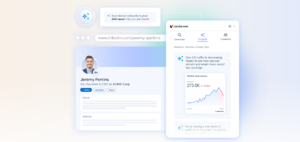By Marcus Tober, Founder and Chief Evangelist, Searchmetrics
From June 2021 Google will begin rolling out a radical update to its search algorithm. The Page Experience update (also known as the Core Web Vitals update) will mean that web pages that provide a better real-world user experience will stand a chance of appearing higher in search results, helping improve brand visibility and engagement.
The Page Experience update measures performance in three key areas:
- How quickly important page content loads (Largest Contentful Paint)
- Responsiveness – the time taken to respond to a visitor’s first interaction, such as clicking on a button/link (First Input Delay)
- Visual stability – does the layout or content jump around, such as when ads or pop-ins appear? (Cumulative Layout Shift)
These signals will be included in Google’s search algorithm, meaning that web pages that are delivering a better experience are likely to receive a ranking boost.
The importance of experience, beyond rankings
The new update is much more than a concern for SEO – it’s actually a far wider issue impacting digital marketing. Clearly, providing a pleasing page experience where pages load quickly, respond to user input and where content doesn’t shift around, is good for everything. It’s going to help reduce ecommerce bounce rates and abandoned shopping carts while being positive for conversions and return visits.
Yet, despite the clear advantages, just 4% of websites currently meet all three of Google’s Page Experience criteria, according to research by Searchmetrics, meaning they risk their rankings being negatively impacted when the update officially rolls out. The study analysed over 2 million web pages appearing in the top 20 Google results in the US, UK, and Germany.
Based on this analysis we see four areas that brands need to focus on when it comes to the Page Experience:
1 Some vertical sectors will be particularly affected
Google itself stresses that having a good page experience doesn’t override having strong, relevant content. However, in many sectors (such as online news or ecommerce) content will be similar or identical on different sites. For example, there won’t be much difference between the information displayed on two retail sites selling the latest Nike trainers. That puts the onus on factors such as page experience if you want to differentiate yourself and potentially move up the rankings.
2 Look for how you can gain competitive advantage
The average scores for Page Experience will vary between sectors, with some potentially finding it more difficult to score top marks. So you need to look at your competitors and how their sites perform – while you should aim to exceed Google’s recommended benchmarks, simply outperforming your rivals could give you a ranking boost.
3 Start now in order to be ready
Google has been transparent about what it is looking for when it comes to delivering a good Page Experience, as well as providing brands with guidance to help them analyse and benchmark performance. That doesn’t necessarily mean that making improvements will be easy, so it is important to start now in order to be ready for when the update rolls out.
Prioritise your activities by following the user journey – start with how quickly the main element on a page loads, then look at time to respond to first interaction, before investigating visual stability. Poor performance when visitors initially come onsite will mean they will simply leave and may never return.
4 The chief culprits behind a poor Page Experience
Some of the biggest Page Experience problems discovered by Searchmetrics are the result of ‘code bloat’, unnecessary code on pages built using the default templates included within content management systems such as WordPress or other out-of-the-box systems. These tend to have a lot of website functionality built-in to make things easy – but a lot of this is never used, meaning you get a lot of overhead for no benefit. The result is slow load times and a poor Page Experience.
Dynamic content (such as ads, pop-ups, and newsletter opt-in boxes) that cause the layout of pages to shift are another major issue if not implemented correctly, reducing visual stability. And, many news sites and other online publications have problems due to auto play pre-roll video. These are designed to play automatically when a visitor arrives on a page, which slows down performance as they have to wait for video content to load.
Delivering the right experience to online visitors has always been vital. The Page Experience update raises the stakes even higher because not paying attention to this will soon start affecting your search visibility.









